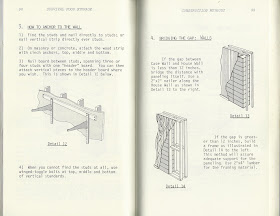The single most astonishing thing about survivalist manuals
is the assumption that life can be conducted as “normal” if an event of such
apocalyptic proportions happens that it wipes out the food supply, water
supply, electricity, etc., and turns your former neighbors into desperate
thieves who want to steal your shit.
There is a smugness to the idea that just because someone on
the “outside” after such an event has not planned in advance like yourself,
then they should suffer. Serves them right. So not only are you supposed to
conduct “normal” family life inside your bunker, but you must also become a
heartless bastard too.
 |
| Shelf after shelf of dehydrated peas. |
Survivalism is a neurosis which finds comfort in math.
Supplies must be calculated by weight and volume in advance, and last for a
specific amount of time at a predictable rate of consumption. The books which
cater to this planning are all about charts and tables.
 |
| How to store food in your walls to prevent your hungry neighbors from getting it. |
The Survival Food
Storage book by Mark and Zhana Thomason goes a step further and is all
about the furniture and very floors and walls of your house. Want to store
enough food for your entire family for a whole year? Then use food containers
to build furniture and stuff them into your walls. This would be awesome if you
want to live in a LEGO style house full of rectangular boxes, but you’d have to
be, as their illustrations suggest, a stick figure to find it at all
comfortable.
 |
| Modular Living at its most modular. |
What they don’t account for is what happens to all your
lovely beds and tables and fish-tank holders and book-cases once you have
depleted your stock. One can imagine a wretched-looking family all eyeing that
last box of dehydrated peas in an empty room with a feral desperation in their
eyes.
On the other hand, they might just succumb to poisoning
brought about by drinking toilet water. Of course one would only resort to that
after drinking the contents of the water bed, and swimming pool. Wait, what? I
thought they couldn’t go outside? Oh — they only recommend doing that if there
is no radioactive fallout. Good call. Don’t drink the glowing water.
 |
| If you're thirsty drink from the toilet reservoir. Never the bowl. |
Survivalists approach their topic with the fervent ardor of
the newly religious, anxious to spread the word (at a cost, of course; they’re
not giving away this advice for free!) to converts. Thus you also find a veritable
treasure trove of like-minded books and pamphlets (all with the same home-typed
feel) at the back. This one lists such gems for the awkwardly worded How To Prosper During The Coming Bad Years,
How You Can Profit From The Coming Price
Controls, and How To Prepare For The
Coming Crash, all of which sound like gripping reads. Also listed are
several Revelations-Style titles as The
Survival Bible, Disaster Survival
Handbook, Passport To Survival,
and Just In Case. (How does one
choose?) In case starvation is an issue, there is Putting Food By, Let’s Try
Barter, Just Add Water, and Making The Best Of Basics.
 |
| Sweetheart, you've lost weight. Let's sit here and dream about food. |
The essential question that underlies all of these books is
what sort of world these folks will expect to find once their year of
self-sufficiency is over.
One with less crates of milk powder, one presumes. And not
enough Kool Aid.
Survival Food Storage,
Mark and Zhana Thomason, 1980


